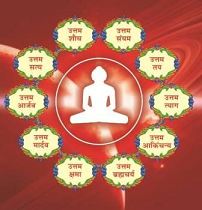UTTAM AKINCHANYA 
He, who abandons the evil thought of attachment to worldly objects, can alone give up possessions.
Not to have the least attachment(Parigraha) is known as Akinchanya (non-attachment). Akinchanya means to put a limit to ambitions, to put a check on desires.
Attachment is of two kinds:
- Internal Attachment - The feeling of love, hatred, affection and ill will for living beings; and wrong belief are internal attachments.
Akinchanya (non-attachment) assists us in being unattached from our internal attachments: false belief, anger, pride, deceit, greed, laughter, liking, disliking, lamentation, fear, disgust, sexual desires.Getting rid the soul of these leads to its purification.
- External Attachment - Greed for wealth and property is external attachment. Greed for worldly possessions (bahayparigrah) consists in desiring more than what is needed by an individual.
Akinchanya (non-attachment)assists the person in detaching from external possessions. Historically ten possessions are listed in Jain scriptures: ‘land, house, silver, gold, wealth, grain, female servants, male servants, garments and utensils’. Being unattached from these, helps control our desires and leads to an influx of meritorious karmas.
As soon as the hopes or ambitions of a man are fulfilled, instantly new ambitions take birth. His desires go on increasing; there is no full stop to them. Therefore, a man should observe the virtue of non-attachment by putting a limit to his ambitions. Acharya Kundkund Swamy has written, 'Desires are limitless. Hopes live eternal in the heart of a man. There is no end to possessions (Parigraha). Still man is running a mad race after possessions and material objects day and night.’
Human being, who has lost his sense of wisdom and power of discrimination due to his over indulgence in lustful desires, is blinder than a man without eyesight. For a blind fails to see with his eyes, but a man blinded by sensuous pleasures cannot grasp the real nature of things; neither by the senses nor by the mind. Therefore, he has misconceived the non-self as the real self. So long as this living being does not forsake this sense of attachment, he will not realize the virtue of non-attachment.
Accumulation of even necessary articles in large numbers, expressing wonder at the prosperity of others, excessive greed and changing the proportions of existing possessions are all forms of Parigraha (worldly attachments). The virtue of non-attachment cannot be attained without discarding both types of Parigrahas (attachments). Only by discarding both, the soul can be made fully purified, clean and spotless. In Shraman culture merely discarding of the external attachments has got no value. Therefore, the living soul (a living being) will be called non-attached only when he gets rid of both internal and external attachments. The Jain scriptures say that attachment equivalent even to a 'Til' (Sesum seed) brings extreme sorrow and suffering in its wake.
A man took resort in a forest renouncing all worldly attachments. At that time, he owned no possessions except a cloth piece. At daytime, he used to wrap it round his body to clothe it, and at night he would spread it on the ground to make a bed to sleep in. In the forest there lived many rats, which nibbled his cloth during night. The man thought of protecting his cloth from the rats somehow. With this idea, he tamed a cat. Milk was needed to feed the cat. So, the man had to tame a cow as well. But grass (fodder) was required for the cow. Now to employ a cowherd became essential for this job. A house was then needed for the cowherd. As soon as the house was built, a maidservant was engaged to look after the house. The maidservant expressed her desire to keep her kith and kin along with her. The man built separate houses for every one of them.
Thus, in some days the forest was filled with the hustle and bustle of the city, yet his troubles went on increasing by leaps and bounds. The underlying idea is that even a petty attachment assumes large dimensions in the long run. Therefore, it is most essential to get rid of attachments at the initial stage. Every man should think that he has certainly to depart from this world one day, leaving behind land, house, gold, sons, wife and relations - in fact leaving even his body. Hence, why all this mad strife for worldly attachments.

